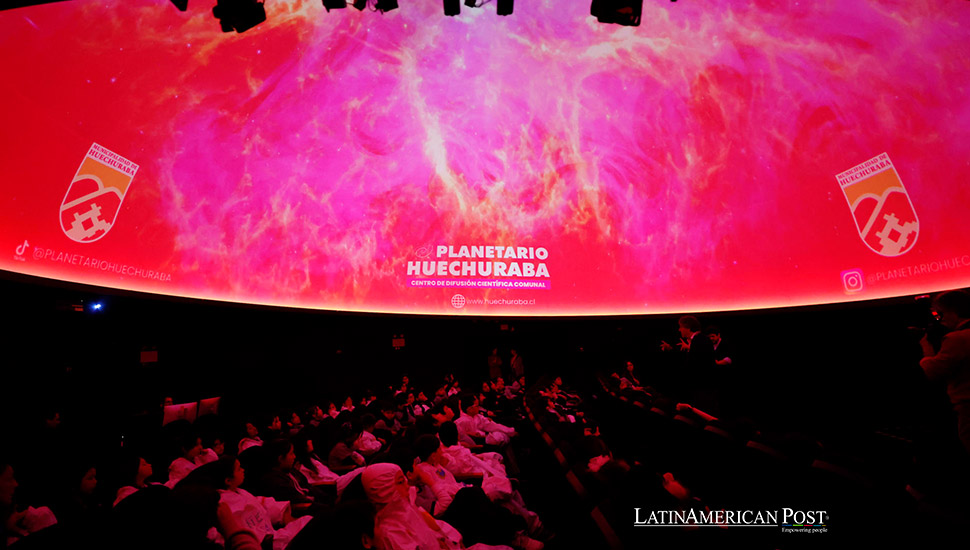Chile’s New Planetarium Aims to Inspire Future Astronomers

Chile, renowned for its clear skies and cutting-edge astronomical projects, has opened a modern planetarium near its capital. Named ‘Aristarco de Samos,’ the planetarium seeks to inspire children and foster a new generation of scientists.
A Nation at the Forefront of Global Astronomy
Chile has long been a global leader in astronomy, thanks to its famously clear skies and strategic investments in scientific infrastructure. With over half of the world’s astronomical capacity expected to be based in Chile by 2030, the country’s commitment to space exploration and scientific advancement is apparent. Chile has added another impressive milestone to its achievements: a new planetarium to inspire the next generation of scientists.
The Aristarco de Samos planetarium inaugurated just two months ago on the outskirts of the Chilean capital, Santiago, is the third of its kind in the country. Nestled in the La Pincoya neighborhood, this state-of-the-art facility was designed to captivate young audiences and serve as a scientific education and community engagement hub. Equipped with advanced technology, the planetarium offers immersive experiences that allow visitors to explore the universe in ways never before possible in Chile.
According to the Ministry of Science, Technology, Knowledge, and Innovation, by 2030, 55.6% of the world’s astronomical data collection capacity will be operating from Chile. With projects like the Extremely Large Telescope (E-ELT) currently under construction and the announcement that Santiago will host the prestigious International Astronomical Union’s (IAU) General Assembly in 2030, Chile is poised to play an even more significant role in the future of global astronomy.
Chile’s unique geographical position and climate have long made it a hotspot for astronomical observation. The northern part of the country, particularly the Atacama Desert, boasts some of the clearest skies on the planet, attracting scientists and astronomers from around the world. Over the past few decades, Chile has become a powerhouse in astronomy, hosting numerous world-class observatories and telescopes.
The country’s astronomical capacity is expected to grow in the coming years. As the Ministry of Science noted, by 2030, Chile will house over half of the world’s astronomical data collection capabilities. This extraordinary concentration of scientific resources places Chile at the forefront of space exploration and research, contributing to groundbreaking discoveries about the universe.
In the northern region of Antofagasta, construction is currently underway on the Extremely Large Telescope (E-ELT), which, when completed, will be the largest optical telescope in the world. This project represents the cutting edge of astronomical research, with scientists hoping to use the E-ELT to explore fundamental questions about the universe’s origins, dark matter, and the potential for life on other planets.
But Chile’s contributions to astronomy aren’t limited to large-scale scientific projects. The country is also committed to fostering a love of science among its younger citizens. The Aristarco de Samos planetarium, which opened its doors just two months ago, is a perfect example of how Chile is working to inspire the next generation of astronomers, engineers, and scientists.
The New ‘Aristarco de Samos’ Planetarium
The Aristarco de Samos planetarium in the La Pincoya neighborhood on the outskirts of Santiago is much more than just a place to watch shows about the stars. It serves as a gateway to the cosmos for its visitors, especially children. The planetarium was designed to inspire young minds and ignite a passion for science and space exploration.
Dafne Iturra, an astronomer at the planetarium, explained that the facility offers a unique learning experience. “The most beautiful thing is seeing different bodies of the solar system or places in our galaxy in a format that allows us to view them in real-time, in multiple dimensions,” Iturra said. She believes that the planetarium’s immersive displays, projected onto a massive 180° aluminum screen, help bring the mysteries of the universe to life for students and visitors.
The planetarium, named after the ancient Greek astronomer Aristarco de Samos, who was the first to propose a heliocentric universe model, is dedicated to education and historical recognition. Aristarco’s groundbreaking theory, which suggested that the Earth revolves around the sun, was largely ignored in his time, only to be confirmed centuries later by Copernicus. By naming the planetarium after Aristarco, the facility’s creators hope to honor his scientific contributions and “restore” his place in history.
Chile’s commitment to education is also evident in how the planetarium is run. According to Carlos Cuadrado, the mayor of Huechuraba, where the planetarium is located, the facility offers free admission to children from public schools. Cuadrado explains this is part of a broader effort to promote social mobility through education. “We believe education is the only real engine of social promotion in Chile,” he said. “We’re starting with the children by making this an educational center.”
For Cuadrado, this initiative is personal. He draws inspiration from the government of Salvador Allende, which he says prioritized children’s well-being as a cornerstone of Chile’s future. Cuadrado’s passion for education and science is evident in the planetarium’s design and mission to inspire the country’s youth.
Technology Meets Education in La Pincoya’s Planetarium
The Aristarco de Samos planetarium’s cutting-edge technology sets it apart from others in the country. According to Jorge Godoy, who manages the planetarium, the facility uses the advanced Digistar 7 system, which connects the planetarium to a global network of similar institutions. This allows the planetarium to perform real-time simulations and offer visitors a truly immersive educational experience.
“Using this 3D tool inside the dome allows us to create simulations in real-time, which is truly amazing,” said Godoy. He emphasized the importance of the planetarium as a milestone for Chile, noting that it’s the first new planetarium to be built in the country in 39 years. “It’s a national milestone, and being able to manage such a project is incredibly motivating,” he said, adding that the enthusiasm from visiting children is one of the most significant rewards of his work.
With a dome spanning 12 meters in diameter and a seating capacity 93, the planetarium offers an immersive experience unlike any other in Chile. Its large, perforated aluminum screen and advanced projection technology allow visitors to travel through the solar system, explore distant galaxies, and witness the wonders of space in stunning detail. For many children, this will be their first introduction to astronomy, and Godoy hopes it will spark a lifelong interest in science.
The planetarium’s commitment to using the latest technology reflects Chile’s broader dedication to scientific advancement. As the country continues to build its reputation as a leader in global astronomy, facilities like the Aristarco de Samos planetarium play a crucial role in ensuring that future generations have the tools and inspiration to pursue careers in science and technology.
Chile’s Role in the Future of Global Astronomy
As Chile looks toward the future, the country’s role in global astronomy is only expected to grow. In addition to hosting the E-ELT, the world’s largest optical telescope, Chile will be the site of the 2030 International Astronomical Union (IAU) General Assembly, the most crucial gathering of astronomers worldwide. This event will further solidify Chile’s position as a global space research and exploration hub.
Aisén Etcheverry, Chile’s Minister of Science, Technology, Knowledge, and Innovation, believes the upcoming IAU assembly reflects Chile’s growing influence in astronomy. “This summit will allow us to continue consolidating the idea that Chile is a country of science,” she said. Etcheverry emphasized that Chile’s success in astronomy is built on international collaboration and the work of its talented researchers, who continue to explore fundamental questions about the universe.
Etcheverry also highlighted the importance of inspiring the next generation of scientists, a mission that is closely aligned with the goals of the Aristarco de Samos planetarium. “Chile has great researchers who help us each day to discover new knowledge about the universe’s origin, explore the possibility of life on other planets, and answer many other fundamental questions,” she said.
As the world looks to Chile for answers about the universe, the country is preparing to nurture the scientists and astronomers of tomorrow. Through initiatives like the Aristarco de Samos planetarium, Chile invests in its future by making science accessible to all, especially its youngest citizens.
Chile’s astronomical achievements have long been recognized on the global stage. Still, with the opening of the Aristarco de Samos planetarium, the country is demonstrating its commitment to fostering a new generation of scientists and explorers. This modern facility in La Pincoya is not only a symbol of Chile’s technological advancement but also a beacon of inspiration for young minds.
With the world’s largest telescope under construction and preparations underway for the 2030 IAU General Assembly, Chile’s role in global astronomy is set to expand even further. As the country continues to push the boundaries of space exploration, the future will depend on its ability to inspire and educate the next generation of scientists.
The Aristarco de Samos planetarium is more than just a high-tech facility—it’s vital to Chile’s long-term vision for scientific growth and innovation. By engaging children, fostering curiosity, and providing access to cutting-edge technology, this planetarium is helping to ensure that the next wave of Chilean astronomers and researchers will be prepared to lead the world in space exploration.
Chile’s investments in astronomical research, its international collaborations, and its focus on education all demonstrate that the country is committed to becoming a leader in the global scientific community. As the world’s attention turns to Chile’s skies and its groundbreaking projects, the nation’s efforts to inspire future generations through spaces like the Aristarco de Samos planetarium will play a critical role in shaping the scientists of tomorrow.
Also read: Google’s Chile Data Center Redesign Sparks Environmental Focus in Latin America
Through this combination of cutting-edge technology, educational outreach, and a passion for discovery, Chile is not only unlocking the mysteries of the universe but also preparing its young people to be at the forefront of scientific advancements for years. The future of astronomy is bright in Chile, and it begins with inspiring the children who will one day lead the way.




